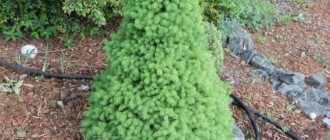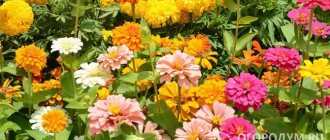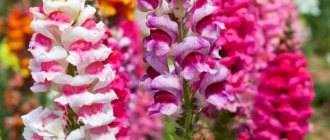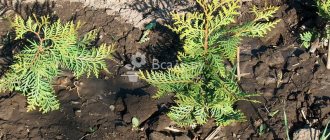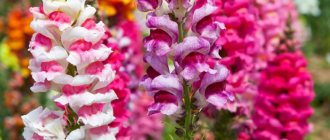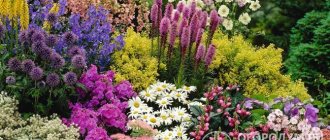If you want to plant coniferous plants in your dacha, then there will certainly be no problems with the assortment: today more than 700 species of the coniferous subclass and a large number of their garden forms are known.
But many of us don’t go to the dacha very often, or maybe we want to spend more time relaxing rather than caring for plants. In this case, your choice is the most unpretentious conifers that require minimal care from you.
The most resistant to cultivation are natural (natural) species, which, due to their considerable size, are suitable only for large summer cottages.
Therefore, we offer 13 of the most unpretentious conifers among decorative forms that will fit perfectly into the design of small cottages. We found the presented forms among junipers, pines and spruces.
Unpretentious varieties of junipers for the Moscow region and central Russia
Juniper Gold Cone
The largest number of non-capricious forms, tested by time and more than one generation of summer residents, are junipers. They grow well on fairly loose, moisture-absorbing, but not heavy soils, both in the sun and in partial shade; some tolerate heavy shade. When there is excess humidity, low-creeping forms are the first to suffer, so it is better to plant them in rockeries and on slopes.
In particular, spectacular compositions are obtained on the site in combination with ferns.
They are harmonious in tall flower beds as hanging plants.
Chinese juniper (Juniperus chinensis) 'Old Gold'
Luxurious juniper, completely justifying its name - “ancient gold”. It is almost like a cube: up to 2 m high and wide. The yellow-bronze color of the needles remains in winter. Very stable.
Juniperus horizontalis (J. horizontalis) 'Andorra Compact'
The horizontal juniper (J. horizontalis) is especially rich in unpretentious decorative forms, for example, the variety 'Andorra Compact'. This is a shrub with a cushion-shaped crown with a height of 0.3 to 0.4 m and a diameter of up to 1 m. The needles are small, scaly, bluish-gray-green, acquiring a slightly purple tint in winter. Light-loving, but tolerates slight shading. Grows well in moist, sandy soils.
Juniperus horizontalis (J. horizontalis) 'Blue Chip'
A slow-growing groundcover shrub for a small rocky home garden, 0.2 to 0.3 cm high and up to 1.5 m in diameter. The needles are silver-blue, slightly purple in winter.
Juniper horizontalis (J. horizontalis) 'Wilton'
Ground cover shrub, spreading in a dense low carpet. At the age of 10 years it reaches a height of 0.1 to 0.15 m. With such a small height, it spreads in width by 2-3 m or more. The needles are silver-blue. Suitable for growing in containers, harmonious in rocky gardens.
Juniperus horizontalis (J. horizontalis) 'Prince of Wales'
Dense low shrub 0.2 m high and approximately 2 m wide. The needles are scaly, thick, bluish-green, with a grayish-pink tint in winter. Grows best in open sunny places and tolerates slight shade.
Juniper (J. squamata) 'Blue Spider'
A very low juniper, only 0.3 m high, but growing up to 1 m wide, with amazingly beautiful emerald needles.
Cossack juniper (J. sabina)
Record holder for endurance! A powerful, rapidly growing species, height from 0.3 to 1.5 m, width from 1.0 to 2.5 m. Its needles are very beautiful.
You can select different types of juniper in our catalog, where products from many gardening online stores are presented. Select juniper seeds and seedlings.
Why don’t conifers take root in the country?
Initially, we want to describe the standard causes of disease in conifers in order to establish why some species do not take root in summer cottages.
Unsuitable climate for conifers
Perhaps you want to grow a plant in your dacha that prefers a frosty and dry climate, and your dacha is located in a region where the climate is different. It is quite possible that, on the contrary, the plant prefers humidity and sun, while your dacha is quite cold and drier. Climate problems are the most important, but they are also trying to get around them. Many people achieve this through adaptation, hardening, and proper preparation of seedlings. But it is more correct to immediately choose those plants that can take root in your climate.
Improper soil conditions
Some species of conifers grow and develop on sandstones all their lives, many can be seen in mountainous areas, among stones, but there are also those that prefer standard country soil. These are again adapted species that have been grown for many years within the city or dacha cooperative, receiving watering, bait, crown formation and other living conditions. These are the ones you should keep as a guideline, and also be sure to clarify on what soils your chosen conifer grows. It is quite possible that the dacha land will not suit him. You may have to choose a different species, or maybe try to create artificial conditions.
Poor quality of seedlings
If we assess the situation roughly, then more than half of the summer residents plant plants that they just liked. The second part consists of experienced summer residents or those who deal with plants professionally. But if we talk about the former, then it is quite difficult for them to choose high-quality seedlings, because even the criteria are sometimes unknown. Therefore, crippled conifer seedlings of the wrong varieties end up at dachas, initially infected with certain diseases, or those most susceptible to pests. The result is the same - the plant does not take root and quickly dies.
Improper care of coniferous plants
You can plant a spruce or pine tree in your dacha, but it is unknown how the coniferous plant will behave in a year or two. Therefore, it is necessary to provide the young tree with high-quality care. Increased attention is required during the first 5-7 years, and this is a mandatory requirement. In the future, it will also be impossible to leave the plant to its own devices - feeding, crown formation, and other care will be required.
It is very important to study the type of plant that is purchased and planted, and the requirements for its cultivation. You cannot use general rules, because each type is individual.
Negative internal environment
Each dacha has its own conditions for plants, which are regulated not only by the entire garden and vegetable garden, but also by neighboring dachas. The situation becomes clearer when you pay attention to the state of your farm. For example, you kill pests, but they appear again because neighbors on both sides of the street do not tend to their garden. The same goes for diseases of trees, shrubs and other plants that easily move from one dacha to another. This can also have a negative impact on conifers, which, for the most part, are quite whimsical.
In addition, pets and even children can be negative for young trees. If a seedling is broken by a dog or kids running around a young Christmas tree, it may not survive. You should create positive conditions for the young tree and try to care for new plants comprehensively. Perhaps in this case the result will be even better than you expected.
There are many reasons for poor growth of coniferous plants, but the main ones are listed above. Try to pay attention to every single detail and correct all the shortcomings. Then you will be able to grow a really healthy and beautiful coniferous plant in your dacha. But also think about the fact that choosing the right type, adapted or simply unpretentious, will help make the task easier!
Unpretentious pines for the Moscow region and central Russia
Pines are light-loving, grow well in open sun, and tolerate partial shade; are drought-resistant, grow well on poor soils and sands, but cannot tolerate stagnant waterlogging.
In plant compositions, pines are incredibly harmonious with many ground cover plants that love the sun: aubriet, saxifrage, borage; With red-leaved barberries, spectacular contrasting compositions are obtained.
Mountain pine (Pinus mugo) 'Winter Gold'
First of all, the forms of mountain pine (Pinus mugo) are unpretentious. These are dwarf coniferous pines, and here are two more unpretentious beauties.
This golden pine with a hemispherical, squat, unevenly developed crown shape on the sides is very consistent with its name - “winter gold”. Its needles are light green in summer and golden yellow in winter. After 10 years of growth, it reaches a height of approximately 0.5 m and a diameter of up to 1 m.
Mountain pine (P. mugo) 'Ophir'
This is another golden winter beauty (green needles in summer) from mountain pines. The incredibly regular, rounded shape of the crown becomes somewhat spreading and unequal with age. At the age of 10 years it reaches a height of 0.5 m and a diameter of 1 m.
Coniferous plants in the garden landscape
Undoubtedly, conifers always look advantageous in landscape design: evergreens remain in their decorative form all year round. In addition, they not only shade other plantings, but also favorably set off bright colors, while themselves remaining in the shade.
Conifers are planted along fences and mesh; dwarf plants will feel great on an alpine hill, along paths, near the house, they frame flower beds and the entrance to the terrace.
Crown shape
The shape of the crown was established initially. In some species it is so strictly defined that it is impossible to make anything else out of it. Pyramidal vertical and spherical horizontal conifers are good in their own way.
Shrubs and low trees can be trimmed to give the crown any desired shape.
Needle color
Another factor that plays in favor of conifers is the color of the crown. The needles can be colored in all shades of green, from delicate greenish to rich, almost dark; There are conifers with bright yellow and golden needles. In some species, the needles change color when weather conditions change.
Watch a short video on how to create a coniferous arrangement in the garden.
Unpretentious spruce trees for the Moscow region and central Russia
Spruce trees are quite shade-tolerant, grow well in damp, but not wetlands, and do not tolerate drought well! Among spruce trees, the following forms have proven to be quite stable in cultivation.
Norway spruce (Picea abies) 'Barryi'
A strong, slow-growing dwarf form of spruce. At the age of 10 years it reaches a height of 2 m. Young plants have a rounded crown shape, which is lost with age. The needles are shiny, dark green, young shoots are orange-brown.
Norway spruce (P. abies) 'Inversa'
An inverted weeping form with an extremely narrow, uneven crown due to shoots falling almost vertically downwards. The lower branches lie beautifully on the ground. The height of an adult plant is from 6 to 8 m, the width is approximately from 2 to 2.5 m. The needles are thick, dark green, shiny. Valued by conifer lovers due to its distinct individuality.
Norway spruce (P. abies) 'Nidiformis'
Unique nest-like dwarf form with a dense cushion-shaped crown. Since the main trunk is missing, shoots from . It grows very slowly: at the age of 10 years it reaches a height of 0.4 to 0.5 m, a width of 1 m. The needles are short. Extremely effective in small groups, rockeries.
Thuja
The most uncapricious representative of conifers. Instead of needles, it has flat branches. A wide range of colors and shapes of this plant allows gardeners to choose the ideal option for their acres.
Types and varieties of thuja (photo)
- folded;
- western;
- eastern
These are the three most popular types of thuja in the middle zone. They take root well in our climate, even in the northern regions. The plant can be trimmed, giving it fancy shapes and figures (cube, ball, pyramid, cone, animal figures, etc.). Therefore, it will become an excellent hedge or an integral part of an ensemble of ornamental plants. Can be planted on rocky hills or along paths.
In order for the plant to please with its appearance, it is better to plant it in a well-lit clearing. It will also grow in the shade, but its branches will not be so fluffy and beautiful. Thuja does not tolerate drought, waterlogged soil and highly acidic soil.
An ideal resident of even the most modest plot of land
Arborvitae are propagated, most often by sowing seeds in autumn. Its growth is quite fast and in the spring you will receive new young seedlings. It can also be propagated by cuttings, but this process is complicated - it is easier to propagate thuja with seeds.
Author of the article: Lastovskaya Lyudmila Viktorovna
Tags: conifers
- Related Posts
- Roses - how to grow on your own plot: planting, pruning, care, diseases and pests
- Perennial flowers for the garden, the beauty of which will take your breath away - name, description, photo
- Aster - secrets of growing from seeds, planting and caring for a flower
« Previous entry
Interesting facts about conifers
Conifers are quite specific plants. In some of them, the lower branches gradually die off, exposing the trunk. It is they, and not angiosperms, who have been living for a very long time; among the trees there are long-livers - sequoias, living for hundreds of years.
Needles are a real storehouse of nutrients and vitamin C.
Pine is one of the most common trees around the globe. Swamp pine needles grow up to 40 cm in length. The pine Pinus parviflora fukai has long needles that are yellowish, and the very tip is dark green.
How do coniferous trees differ from deciduous trees?
There are many differences between coniferous and deciduous trees:
- the largest number of coniferous forests grows in the taiga, there are much fewer of them than deciduous or mixed ones;
- in a coniferous forest, small vegetation has very little chance, because the trees do not tolerate competitors;
- the air in coniferous forests is saturated with substances that disinfect it and have the most beneficial effect on a person’s physical and mental health;
- many types of mushrooms can be found exclusively in coniferous forests;
- as decoration, conifers are preferable to deciduous trees, since they do not shed their needles and retain their appearance even in winter;
- Coniferous trees are much hardier than deciduous trees and are less demanding on living conditions.
